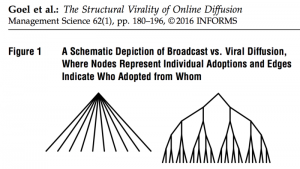
In the beginning, there was Twitter.
Now Twitter had a lot of stuff, and it all moved really fast. Frustrated tweeters asked, “How can we find and participate in discussions about stuff we care about in all this mess?”
And lo, in 2007 the hashtag was born. And it was good.
Hashtags gave us a handy stamp to designate our tweets as belonging to a certain conversation without taking up too much of our character count. Last week, for example, I had the pleasure of presenting at a conference in DC. Instead of tweeting that we were at the Social Media for Health Care Marketing Conference (49 characters), all of us attendees were invited to code our tweets with the hashtag #ali_hcmktg (11 characters) to get a lively conference-related conversation going.
So well did the Twitter hashtag catch on that other networks, unfettered by character limits, also desired its community- and conversation-building magic. Facebook, Instagram, LinkedIn — everybody wanted a piece of the action. Heck, even the super-smart folks at Oxford Dictionary bought into the buzz, adding the word “hashtag” to the OED in 2014.
Fast-forward to 2017, and the hashtag is arguably the most misunderstood, most horrifically abused convention in the socialverse, to the point where many marketers have abandoned it altogether. Just how did we get here? And what (if anything) can we do about it? Are hashtags just not worth the trouble anymore … or, even worse, do they cause more harm than good?
Search Got Smarter
Let’s face it: Part of the reason why hashtags became so popular was that for a long time, social search kinda sucked. Okay, it sucked a lot.
Over the last decade or so, social search has gotten much, much better. Type in a keyword or two related to a topic you care about, and you’ll probably find the posts you’re looking for. No hashtag necessary.
Not only has search within social platforms improved, but online search itself has jumped in on the social search scene. When the news broke about the Oakland Raiders moving to Las Vegas, I hopped over to Google, who was kind enough to present the latest tweets right there in my search results:

So part of the reason for the decline of the hashtag is that we just don’t need them like we used to. But there’s another reason, one far more distasteful …
Spammers Gonna Spam
Oh, spammers, must you ruin absolutely everything?
Answer: Yes.
As use of and interest in hashtag conversations grew, spammers quickly recognized a new, untapped opportunity for perpetrating their nefarious craft. It was wickedly simple: Hop on Twitter, pick out a hashtag that’s trending (they give you a handy list right there in the left column), and plaster that puppy on every one of a barrage of tweets hawking whatever crap it is you’re selling. Sure, most of the clicks you’ll get will be accidental, but hey, clicks are clicks, right?
As I was researching the spam problem with hashtags, I came across the case of The Guardian’s 2012 Activate NYC conference, which had to change its hashtag mid-conference because of the deluge from spam bots:
Twitter spam is so bad for #ActivateNYC hashtag that we’re switching to #ActivateNYC12. First time I’ve seen conference overrun like that.
— David Weiner (@daweiner) May 3, 2012
Unreal.
I should mention that hashtag spamming is part of a larger spam problem that’s been plaguing Twitter for years, and that’s another story for another day. But suffice to say that spammers — as spammers are wont to do — have once again taken something good and useful and warped it into a tool of evil. Whether the hashtag can survive such abuse and remain a force for good, I can’t be certain.
The State of Hashtags in 2017
So where, exactly, does that leave us? Is it time to trudge up the slopes of Mount Doom and toss hashtags into the fiery pit of Mordor?
Not quite yet. Hashtags still have a legitimate place in our social media strategies in 2017 … if we use them wisely and appropriately. And that all begins with learning the norms and expectations for each social network.
Hashtags on Twitter
Hey, Twitter invented the hashtag, and it’s still the hub of most of the hashtag activity on the social web, for good and for ill — mostly ill. Yes, 99 percent of the hashtag activity on Twitter is crap. The one instance where hashtags still shine on Twitter is the live event: conferences, live broadcasts, and expert chats. Make sure to assign a hashtag to every live event you host, and promote the crap out of it, both before and during.
Hashtags on Facebook
Facebook has been doing the hashtag thing since 2013, and to be honest, it never really caught on. Today, not only will hashtags not help you build a Facebook following; they can actually hurt your engagement.
When Buzzsumo analyzed 1 billion Facebook posts (yes, that’s billion with a b), they made a shocking discovery: Facebook posts without hashtags got more engagement than posts with hashtags. Any hashtags. Like, at all.

So if you’re looking to grow engagement on Facebook, you’re actually better off skipping hashtags altogether.
Hashtags on LinkedIn
Like Facebook, LinkedIn also jumped on the hashtag bandwagon in 2013, but later abandoned them due to “poor user response.” In an odd move, the network restored hashtag support in August 2016. Adoption among users seems to be slow and tentative, so file this one under “too soon to tell.”
Hashtags on Snapchat
Gotcha! Snapchat doesn’t support hashtags. You’re welcome to add one for irony or jaunty commentary on your snap, but tapping on it won’t do a damn thing. And of course, there’s no search whatsoever on Snapchat, so there you go.
Hashtags on Instagram
Instagram is the one environment where the hashtag question can be answered with an enthusiastic “yes — go for it.”
In a 2016 study, TrackMaven discovered that the optimal hashtag count for engagement on Instagram is … wait for it … nine. Yep, you read that right. Apparently Instagram audiences can’t get enough of hashtags. I’m guessing it goes back to the visual-only nature of Instagram content: images and videos need hashtags to make them more discoverable through search.
Bottom Line on Hashtags
Are hashtags really dead? If we’re talking the tired old approach of vomiting as many tags as possible — with varying degrees of relevance — into every post we publish, then the answer is yes.
But if we’re talking about the thoughtful use of strategically chosen hashtags to initiate and participate in focused conversations, then we can say with certainty that they are very much alive.
So how do we steer clear of the spam slum and use hashtags to our greatest benefit … without annoying our audiences? Forget the hype and approach hashtags like the savvy, strategic marketer you are.
- Select your hashtags carefully. Steer clear of overly general terms and think about the “long tail” interests of your specific audience.
- Be purposeful. Don’t just use hashtags to use them.
- Leverage the power of hashtags to foster conversations around live events.
- As always, track your results and determine the approaches that work best for your organization.
So, Mr. Hashtag, it looks like you’ve been given a new lease on life in the hands of the conscientious marketer. Don’t let the spammers blow it for you this time. Remember, we still know the way to Mordor.

Find out why Joe Pulizzi, Founder of the Content Marketing Institute, had this to say about The Content Marketing Coach: Everything You Need to Get in the Game … and WIN:
“A simple yet effective guide to an approach that most businesses get flat out wrong. Do yourself and your business a favor and take a deep dive into this book. You won’t regret it.”
Digital & Social Articles on Business 2 Community(96)
Report Post








